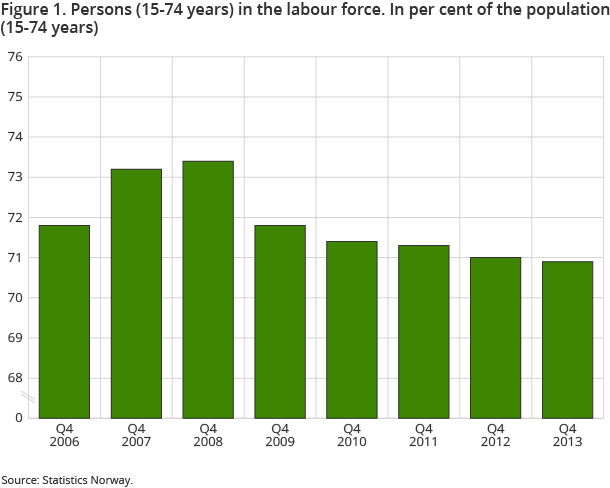Content
Published:
This is an archived release.
Decreased labour force participation among men
From the 4th quarter of 2012 to the 4th quarter of 2013, the labour force participation among men decreased, while increasing somewhat among women. The total labour force participation therefore remained largely unchanged.
| 4th quarter 2013 | 4th quarter 2012 - 4th quarter 2013 | |||
|---|---|---|---|---|
| Absolute numbers | Per cent | Change in absolute numbers | Change in percentage points | |
| Labour force | ||||
| Both sexes | 2 707 000 | 70.9 | 31 000 | -0.1 |
| Males | 1 428 000 | 73.3 | 11 000 | -0.5 |
| Females | 1 279 000 | 68.3 | 21 000 | 0.2 |
| Employed persons | ||||
| Both sexes | 2 619 000 | 68.6 | 30 000 | -0.1 |
| Males | 1 380 000 | 70.9 | 13 000 | -0.3 |
| Females | 1 239 000 | 66.2 | 17 000 | 0.1 |
| Unemployed | ||||
| Both sexes | 88 000 | 3.2 | 2 000 | 0.0 |
| Males | 48 000 | 3.3 | -2 000 | -0.2 |
| Females | 40 000 | 3.1 | 4 000 | 0.2 |

The Labour Force Survey (LFS) shows that 70.9 per cent of persons aged 15-74 years participated in the labour force in the 4th quarter of 2013. This was down 0.1 percentage points from the 4th quarter of the previous year. Since the population growth during this period was somewhat stronger than the growth of the labour force, the labour force as a share of the population decreased. The decrease was for men, while a decrease of 0.2 percentage points was experienced for women – to 68.3 per cent in the 4th quarter of 2013. The labour force participation among men decreased from 73.8 per cent in the 4th quarter of 2012 to 73.3 per cent in the 4th quarter of 2013. Most of this decrease was among men aged 45-49 and 55-59 years.
30 000 more employed last year
The LFS shows an increase of 30 000 employed persons from the 4th quarter of 2012 to the same quarter of 2013. The increase was among both women and men. The increase was in full-time employment for both sexes, even though part-time employment is far more widespread among women. In the 4th quarter of 2013, 40 per cent of the employed women worked part-time – compared to 14 per cent among employed men.
More jobs within academic professions
The share of employed persons with academic professions increased from 25.2 per cent in 2011 to 26.5 per cent in 2013. Academic professions are professions that today normally require at least four years of higher education. In 2013, 20.9 per cent of employed persons worked within sales and service professions.
Stable share of temporary employees
The 202 000 temporary employees in the 4th quarter of 2013 corresponded to 8.3 per cent of total employees. The share of temporary employees has been around 8 per cent in the whole period 2009-2013. Temporary employment is most widespread within education, accommodation and food service activities, as well as health care and social work activities.
Youth not in employment or education
In 2013, 7 per cent of persons under the age of 30 were not in employment, education or training (NEET). This share has been around 6-7 per cent in most of the period 2006-2013, and there were 70 000 persons in this group in 2013. Among these, 25 000 were unemployed .
Contact
-
Arbeidsmarked og lønn
E-mail: arbeidsmarked@ssb.no
-
Erik Herstad Horgen
E-mail: erik.horgen@ssb.no
tel.: (+47) 93 08 68 62
-
Håvard Hungnes Lien
E-mail: havard.lien@ssb.no
tel.: (+47) 40 90 26 06
